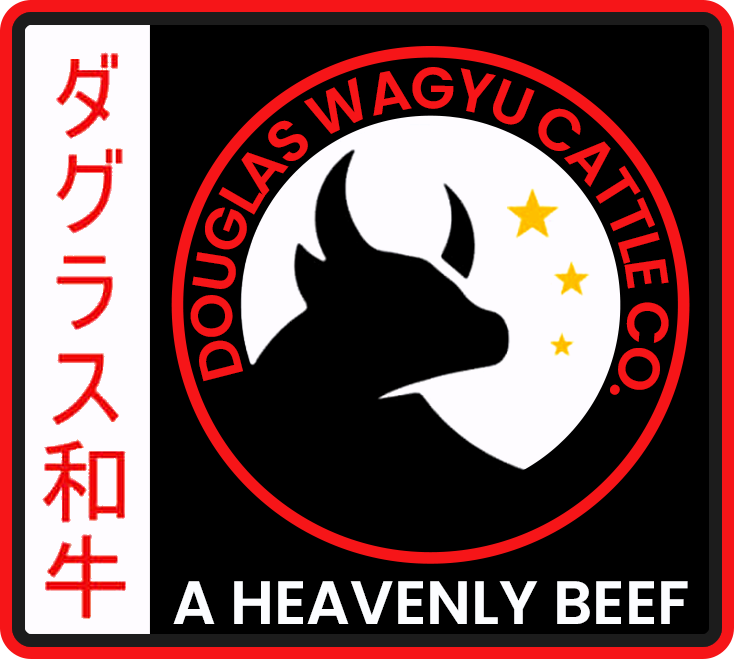ABOUT WAGYU
What are wagyu cattle?
Wagyu is a breed of beef cattle originating in Japan. Pronounced ‘wagyu-’, it literally means ‘Japanese cow’. Wagyu cattle are significantly different than all other breeds because of their unique meat quality attributes.
Wagyu beef is popular around the world because of its superior eating quality compared with other breeds of cattle. Not only does wagyu beef have higher levels of intra-muscular fat, or marbling, but the meat texture is finer, resulting in a more flavorsome eating experience. A ‘super beef’ of sorts, wagyu is known for its marbled appearance and for being so tender it melts in your mouth.
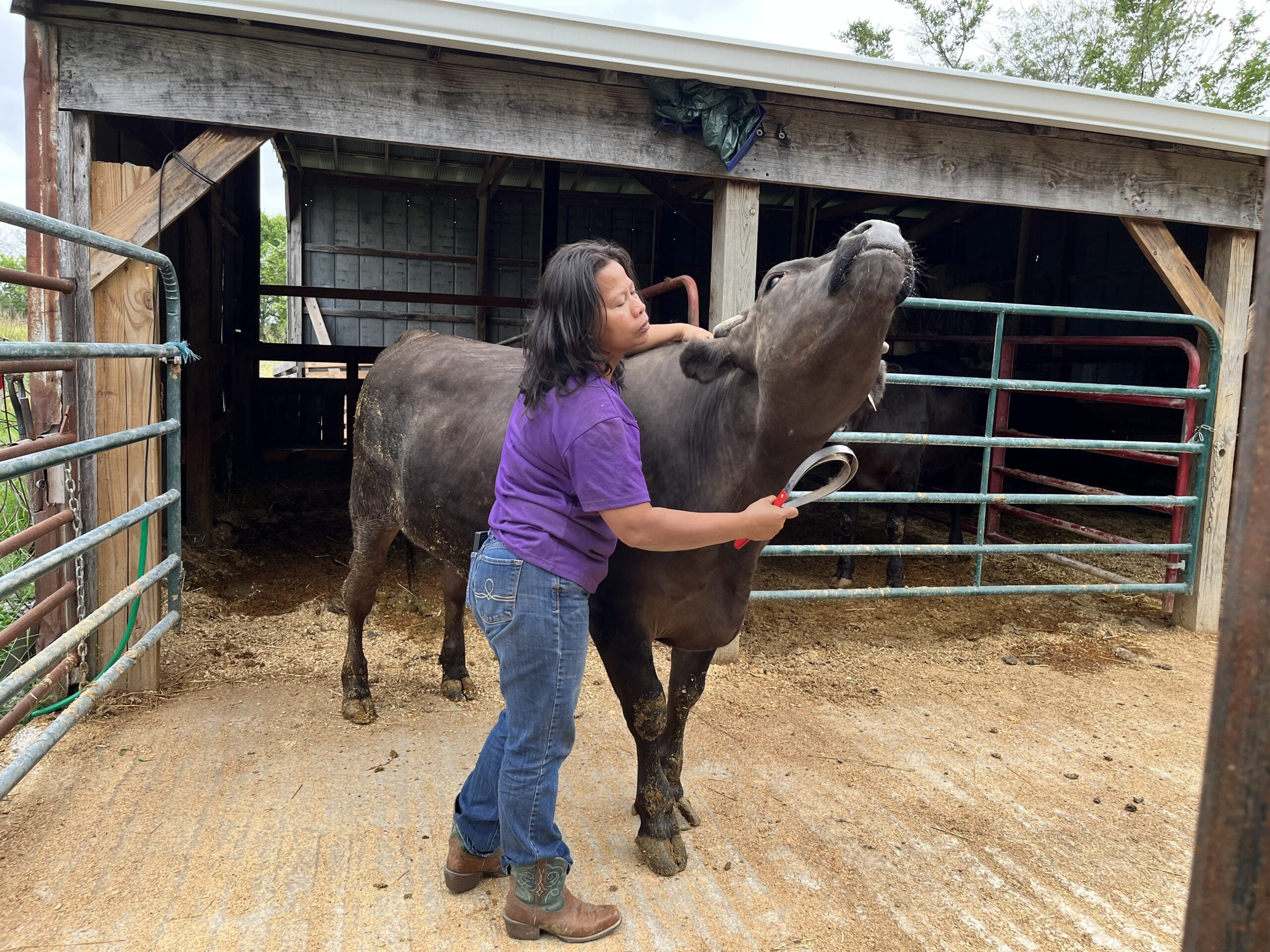
In Japan, there are four genotypes that make up the wagyu breed – Japanese Black, Japanese Brown, Japanese Shorthorn and Japanese Polled. Originally, the Japanese used wagyu as working cows, because of their robust stature and physical endurance. However, over the years, the breed has become revered to the point that in 1997 the Japanese Government declared wagyu as a national treasure and banned exports of the cattle to other countries.
Luckily, some embryos and live cattle had already been exported from Japan to the US prior to 1997 and is where Australia and other countries sourced their first wagyu genetics in the early to mid-1990s.
Why is wagyu so good?
Those in the know reckon wagyu is unparalleled in its taste. Its abundance of fat ensures a tender, juicy and flavorsome eating experience. The fat in wagyu has a melting point lower than the human body temperature, which is what makes it melt in your mouth.
Myths abound of wagyu cattle being reared in veritable cow day spas, being fed gourmet food and drink, being massaged and even serenaded to produce better beef. While some producers do have unique ways of raising their wagyu, most Wagyu in the US are raised in pasture/feedlots and a some of the beef quality is lost. Douglas Wagyu Cattle Company raises our Wagyu according to strict rearing guidelines. Just like Japan, our wagyu cattle are fed on special rations to maximize the marbling, only drink fresh well water, and are barn raised in a low stress environment.
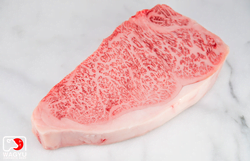
(Japanese A5 steak)
To qualify for wagyu certification in Japan, cattle have to be fed a special diet predominantly made up of grains and bred on fattening farms where they’re given a name instead of a number. Wagyu live longer than other beef cattle, which also significantly improves the flavor of the beef. In general Wagyu cows live for 28-34 months before being processed, whereas normal beef cattle are processed at about 15-18 months. At Douglas Wagyu Cattle Co. they are fed to 34 months. Best of all, wagyu is not only mouth-watering delicious, it’s proven to be good for you, too. Wagyu comes packed with a higher concentration of monounsaturated fats (the good fats), omega-3s, omega-6s, and omega-9s, other beef does not have this benefit because they produce amino acids differently than Wagyu cattle.
Wagyu is also high in conjugated linoleic acid, a naturally occurring fatty acid which is also a popular dietary supplement. Health wise, eating a wagyu steak is more like eating a piece of wild caught salmon.
Why Douglas Wagyu Cattle Company is different.
In America to label a package of meat Wagyu, the meat must only be 50% Wagyu. While this product is less expensive and heathier than traditional beef, it still does not bring the full experience of fullblood Wagyu. There are multiple ways to grow fullblood Wagyu beef, but Jake and Cristina are passionate about food and wish to grow the best steaks in the US and to do this they follow the Japanese method of raising Wagyu. While raising Fullblood Wagyu in a feedlot style environment does produce some impressive results with high marbling, the texture and taste can be different from barn raised Wagyu because of the stress environment. We believe that low stress, clean water, time, and the right feed makes better beef. Additionally, our cows are hormone and antibiotic free. You can see from our photos that our cows are loved.
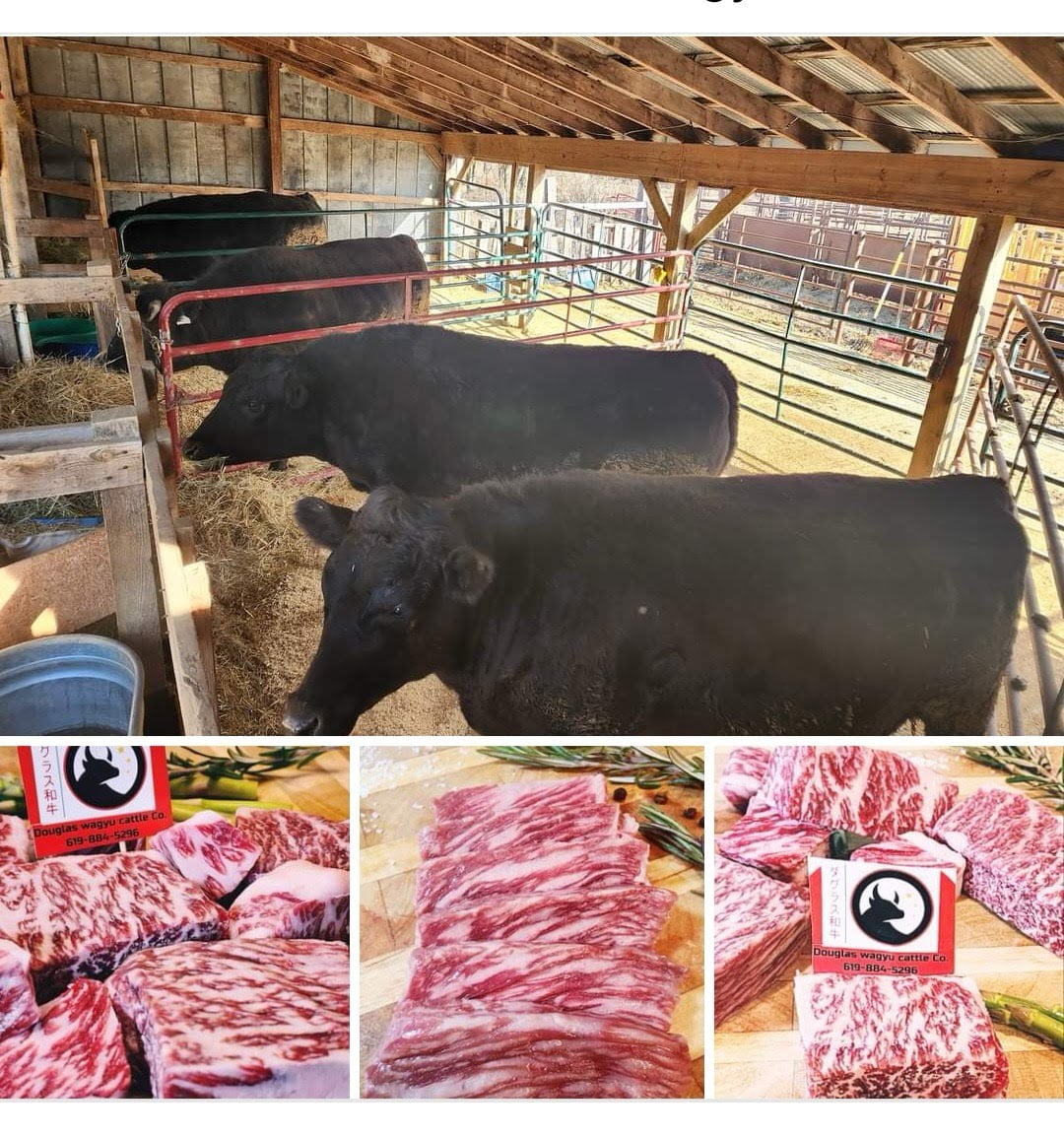
In Japan the grading system for Wagyu beef is A-1 to A-5 with A-5 being the highest grade. A-5 is what Douglas Wagyu is driving towards and we will not stop until we get there. We encourage people to order an A-5 steak from Japan (appox $150), this can be done through websites like crowdcow.com. While this price seems high, one steak will typically feed two people. Once you have one of these steaks you will understand our passion and know that not all Wagyu is the same.
Please understand that Douglas Wagyu Cattle Co. is a growing business and demand is currently exceeding our capacity, but we are continuously growing our farm and are doing everything possible to get you this amazing product.
Proper cooking of wagyu.
Please don’t try to cook your fullblood wagyu beef the same way you would cook other beef, there are several websites and Youtube videos that teach the proper way to cook wagyu so that you get the amazing experience that you have paid for.
Also, keep in mind that our wagyu steaks are significantly richer than other beef and would recommend you serve half the portion size of normal beef.
Wagyu Health Benefits
Wagyu Beef For Superior Taste
Wagyu beef is popular around the world because of its unique intramuscular fat and meat texture which results in heavenly flavor and beef so tender it melts in your mouth. Wagyu cattle originated in Japan. “Wa” means Japanese and “gyu” means cattle. The intensive feeding system, finishing diet, and breed type increases fat deposition compared to European breeds. This results in the improved juiciness and flavor (Gotoh & Seon-Tea, 2016; Motoyama et al., 2016 & Smith, 2016).
WAGYU BEEF FOR SUPERIOR HEALTH
- Heart health: Wagyu beef is higher in Omega 3 and 6 fatty acids which help blood circulation and enhance heart health (Bermingham et al., 2018; Troy et al., 2016). Wagyu beef is higher in mono-unsaturated fats than other meats. These are heart-healthy fats because they lower bad cholesterol and increase the good which may reduce risk factors for cardiovascular disease (Gotoh & Seon-Tea, 2016; Roussell et al., 2012).
- Reduced diabetes risk: Smith (2016) found that the longer cattle feed the more oleic acid they deposit. Oleic acid is found in olive oil and salmon and has positive healthy benefits. Because of the longer feeding and finishing diet of Wagyu beef it is higher in healthy oleic acid. Gillmore (2013, 2011) indicated that increasing oleic acid potentially increases the healthfulness of beef because it reduces serum insulin which reduces the risk for type II diabetes.
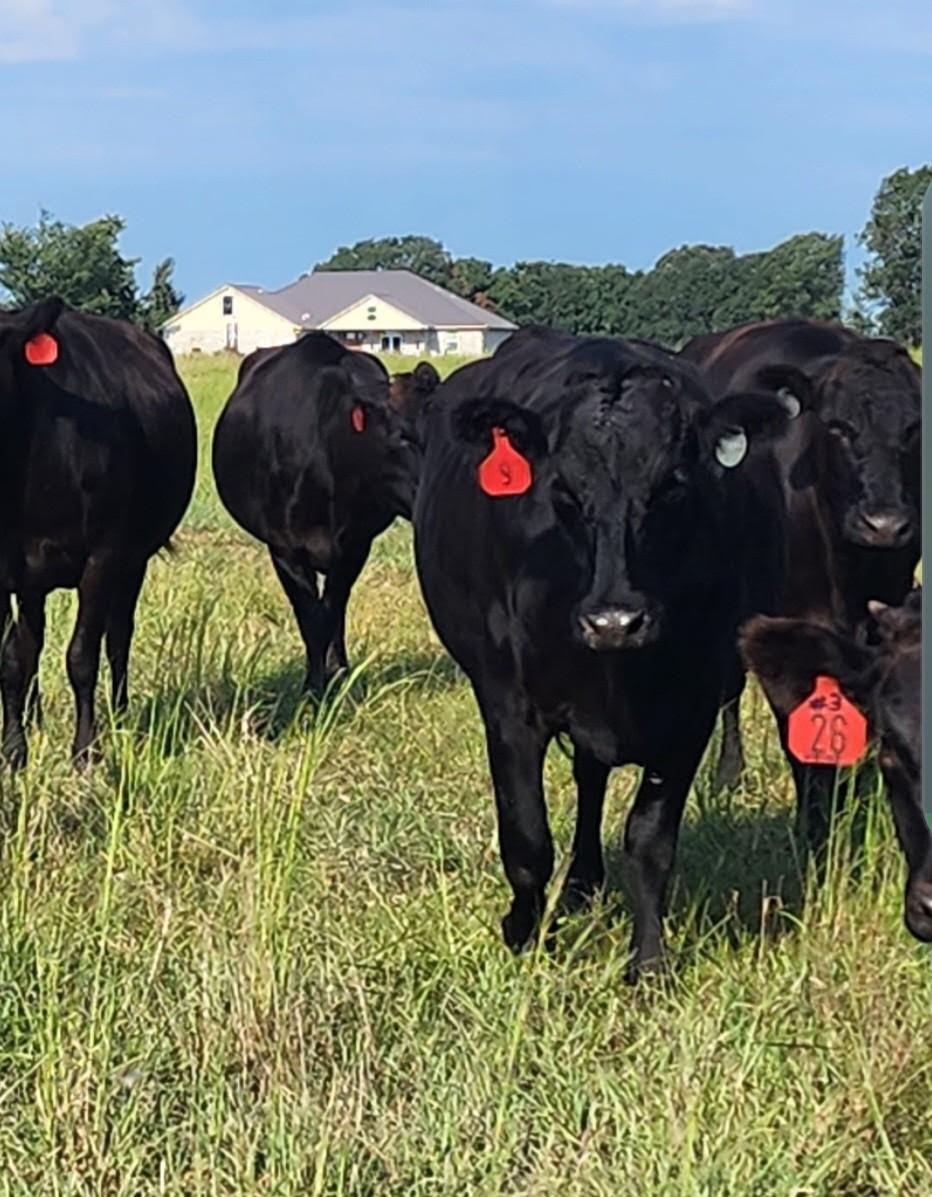
REFERENCES
Bermingham, E. N., Reis, M. G., Subbaraj, A. K., Cameron-Smith, D., Fraser, K., Jonker, A., & Craigie, C. R. (2018). Distribution of fatty acids and phospholipids in different table cuts and co-products from New Zealand pasture-fed Wagyu-dairy cross beef cattle. Meat Science (140), 26-37.
Gilmore L. A., Crouse S. F., Carbuhn A., Klooster J., Calles J. A. E., Meade T., & Smith S. B. (2013). Exercise attenuates the increase in plasma monounsaturated fatty acids and high-density lipoprotein but not high-density lipoprotein 2b cholesterol caused by high-oleic ground beef in women. Nutritional Research, (33), 1003–1011.
Gilmore L. A., Walzem R. L., Crouse S. F., Smith D. R., Adams T. H., Vaidyananthan V., Cao X., & Smith S. B. (2011). Consumption of high-oleic acid ground beef increases HDL cholesterol concentration but both high- and low-oleic acid ground beef decrease HDL particle diameter in normocholesterolemic men. Journal of Nutrition, (141), 1188–1194.
Gotoh, T., & Seon-Tea, J. (2016). Characteristics and health benefit of highly marbled Wagyu and Hanwoo beef. Korean Journal for Food Science of Animal Resources, 36(6), 709-718.
Motoyma, M., Sasaki, K., & Watanabe, A. (2016). Wagyu and the factors contributing to its beef quality: A Japanese industry overview. Meat Science, (120), 10-18.
Roussell, M. A., Hill, A. M., Gaugler, T. L., West, S. G., Vanden Heuvel, J. P., Alaupovic, P., Gillies, P. J., & Krist-Etherton, P. M. (2012). Beef in an optimal lean diet study: Effect on lipids, lipoproteins, and apolipoproteins. The American Journal of Clinical Nutrition 95(1), 9-16.
Smith, S. B. (2016). Marbling and its nutritional impact on risk factors for cardiovascular disease. Korean Journal for Food Science of Animal Resources, 36(4), 435-444.
Smith, S. B. (2016, April 22). Long-term study of fatty acid composition of Wagyu beef. Texas Wagyu Association General Meeting, Salado, TX. https://www.texaswagyuassociation.org/stephen-b-smith-regents-professor/
Troy, D. J., Tiwari, B. K., & Seon-Tea, J. (2016). Health implications of beef intramuscular fat consumption. Korean Journal for Food Science of Animal Resources, 36(5), 577-582.
